maintenance DODGE CHARGER 2019 Vehicle Warranty
[x] Cancel search | Manufacturer: DODGE, Model Year: 2019, Model line: CHARGER, Model: DODGE CHARGER 2019Pages: 270, PDF Size: 2.52 MB
Page 223 of 270
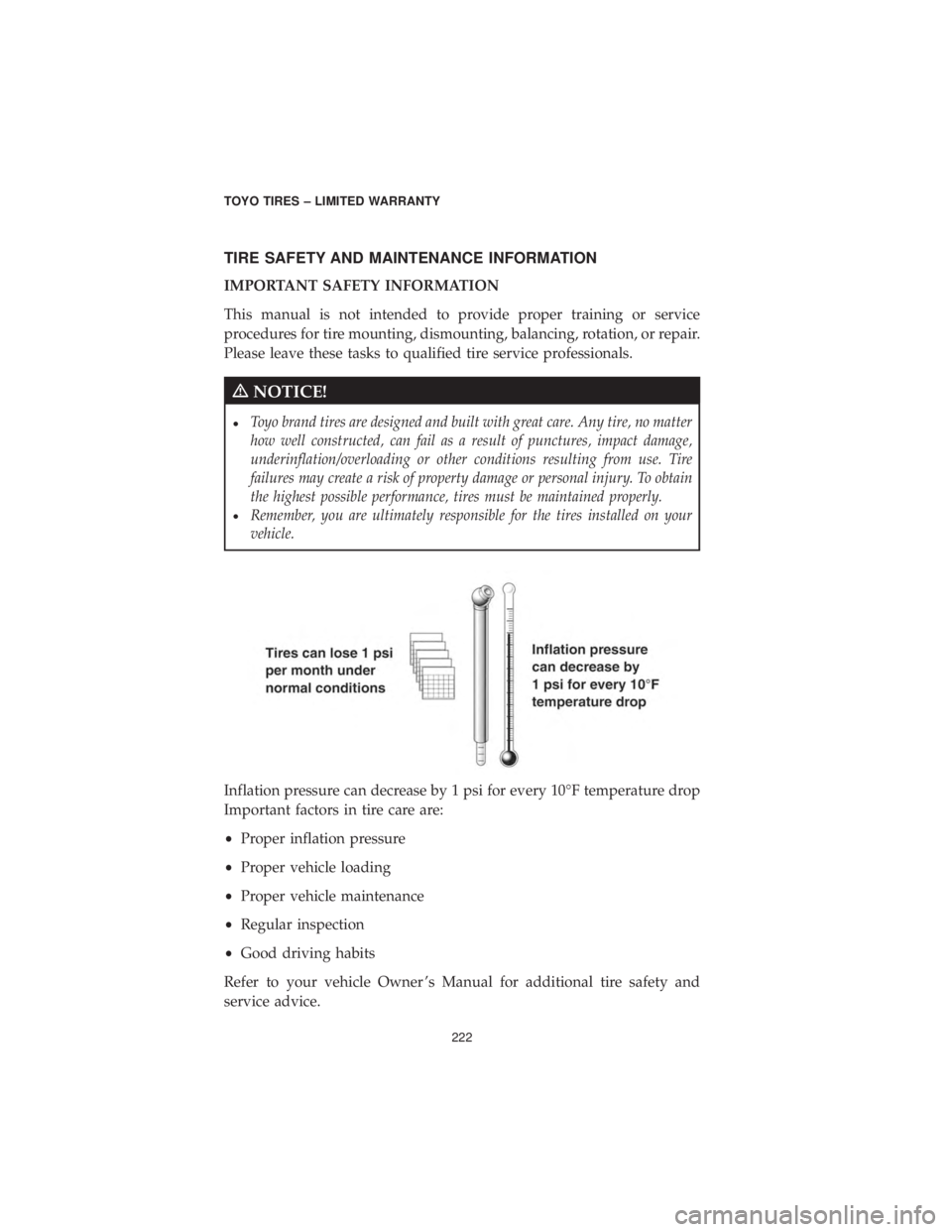
TIRE SAFETY AND MAINTENANCE INFORMATION
IMPORTANT SAFETY INFORMATION
This manual is not intended to provide proper training or service
procedures for tire mounting, dismounting, balancing, rotation, or repair.
Please leave these tasks to qualified tire service professionals.
mNOTICE!
•Toyo brand tires are designed and built with great care. Any tire, no matter
how well constructed, can fail as a result of punctures, impact damage,
underinflation/overloading or other conditions resulting from use. Tire
failures may create a risk of property damage or personal injury. To obtain
the highest possible performance, tires must be maintained properly.
•Remember, you are ultimately responsible for the tires installed on your
vehicle.
Inflation pressure can decrease by 1 psi for every 10°F temperature drop
Important factors in tire care are:
• Proper inflation pressure
• Proper vehicle loading
• Proper vehicle maintenance
• Regular inspection
• Good driving habits
Refer to your vehicle Owner ’s Manual for additional tire safety and
service advice.
TOYO TIRES – LIMITED WARRANTY
222
Page 230 of 270
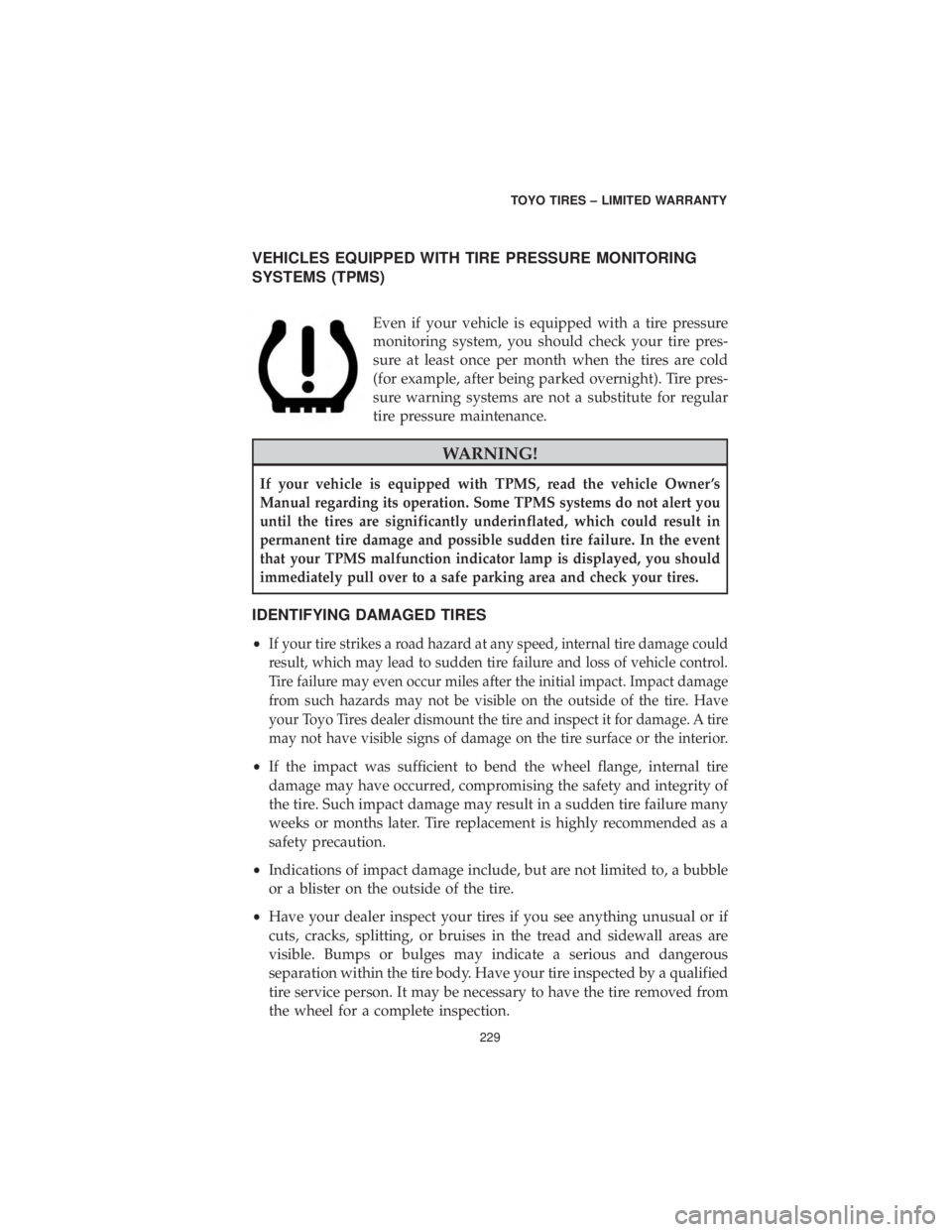
VEHICLES EQUIPPED WITH TIRE PRESSURE MONITORING
SYSTEMS (TPMS)
Even if your vehicle is equipped with a tire pressure
monitoring system, you should check your tire pres-
sure at least once per month when the tires are cold
(for example, after being parked overnight). Tire pres-
sure warning systems are not a substitute for regular
tire pressure maintenance.
WARNING!
If your vehicle is equipped with TPMS, read the vehicle Owner ’s
Manual regarding its operation. Some TPMS systems do not alert you
until the tires are significantly underinflated, which could result in
permanent tire damage and possible sudden tire failure. In the event
that your TPMS malfunction indicator lamp is displayed, you should
immediately pull over to a safe parking area and check your tires.
IDENTIFYING DAMAGED TIRES
•If your tire strikes a road hazard at any speed, internal tire damage could
result, which may lead to sudden tire failure and loss of vehicle control.
Tire failure may even occur miles after the initial impact. Impact damage
from such hazards may not be visible on the outside of the tire. Have
your Toyo Tires dealer dismount the tire and inspect it for damage. A tire
may not have visible signs of damage on the tire surface or the interior.
• If the impact was sufficient to bend the wheel flange, internal tire
damage may have occurred, compromising the safety and integrity of
the tire. Such impact damage may result in a sudden tire failure many
weeks or months later. Tire replacement is highly recommended as a
safety precaution.
• Indications of impact damage include, but are not limited to, a bubble
or a blister on the outside of the tire.
• Have your dealer inspect your tires if you see anything unusual or if
cuts, cracks, splitting, or bruises in the tread and sidewall areas are
visible. Bumps or bulges may indicate a serious and dangerous
separation within the tire body. Have your tire inspected by a qualified
tire service person. It may be necessary to have the tire removed from
the wheel for a complete inspection.
TOYO TIRES – LIMITED WARRANTY
229
Page 263 of 270
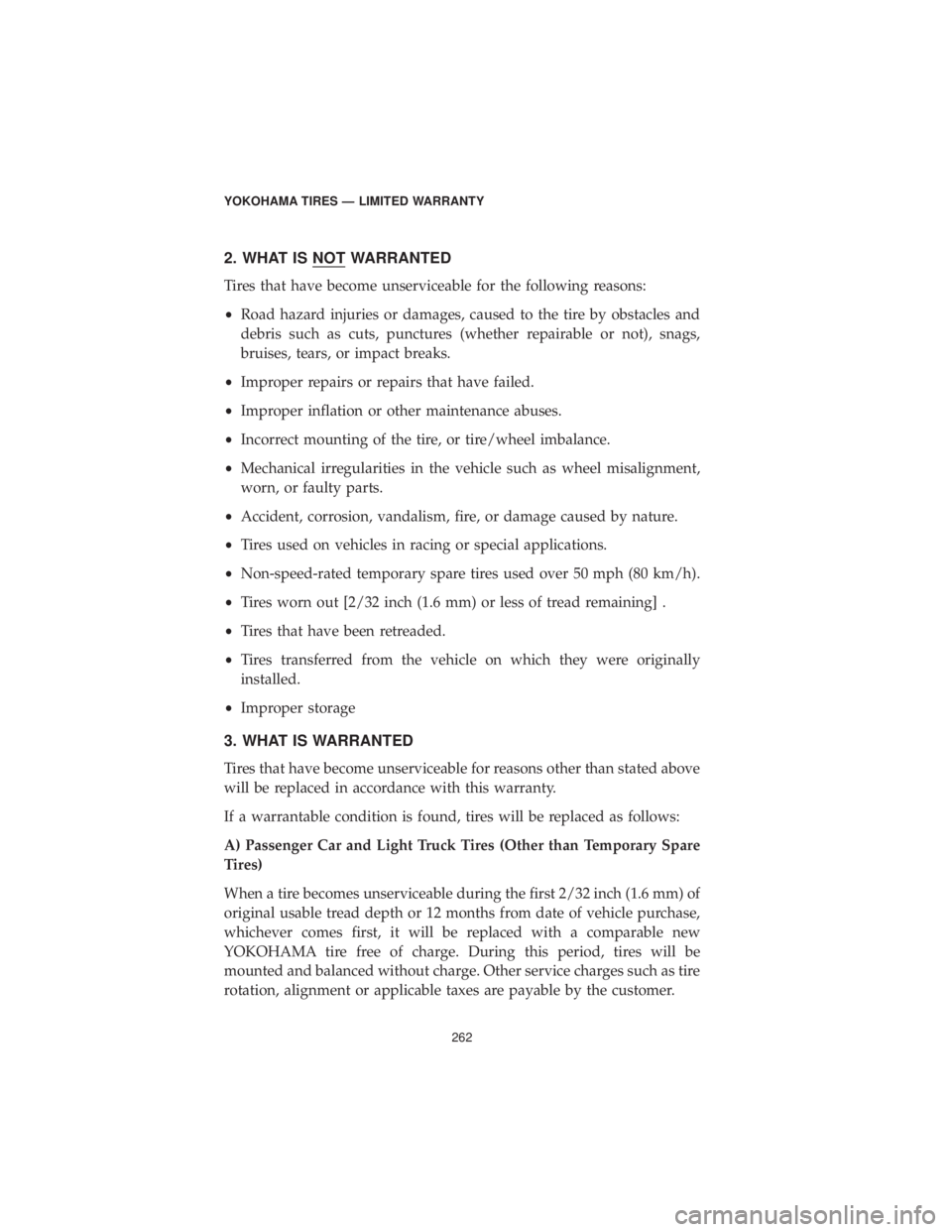
2. WHAT IS NOT WARRANTED
Tires that have become unserviceable for the following reasons:
•Road hazard injuries or damages, caused to the tire by obstacles and
debris such as cuts, punctures (whether repairable or not), snags,
bruises, tears, or impact breaks.
• Improper repairs or repairs that have failed.
• Improper inflation or other maintenance abuses.
• Incorrect mounting of the tire, or tire/wheel imbalance.
• Mechanical irregularities in the vehicle such as wheel misalignment,
worn, or faulty parts.
• Accident, corrosion, vandalism, fire, or damage caused by nature.
• Tires used on vehicles in racing or special applications.
• Non-speed-rated temporary spare tires used over 50 mph (80 km/h).
• Tires worn out [2/32 inch (1.6 mm) or less of tread remaining] .
• Tires that have been retreaded.
• Tires transferred from the vehicle on which they were originally
installed.
• Improper storage
3. WHAT IS WARRANTED
Tires that have become unserviceable for reasons other than stated above
will be replaced in accordance with this warranty.
If a warrantable condition is found, tires will be replaced as follows:
A) Passenger Car and Light Truck Tires (Other than Temporary Spare
Tires)
When a tire becomes unserviceable during the first 2/32 inch (1.6 mm) of
original usable tread depth or 12 months from date of vehicle purchase,
whichever comes first, it will be replaced with a comparable new
YOKOHAMA tire free of charge. During this period, tires will be
mounted and balanced without charge. Other service charges such as tire
rotation, alignment or applicable taxes are payable by the customer.
YOKOHAMA TIRES — LIMITED WARRANTY
262
Page 265 of 270
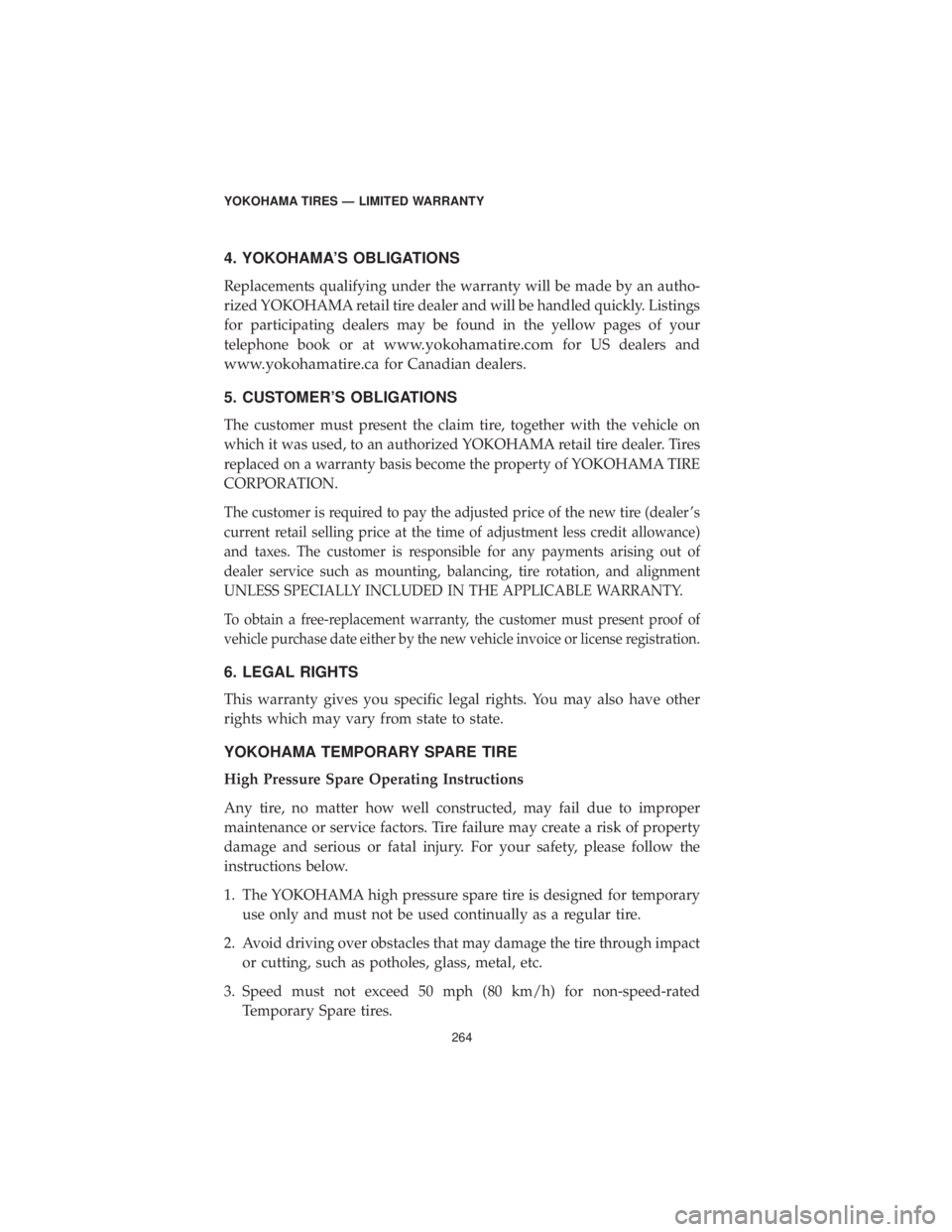
4. YOKOHAMA’S OBLIGATIONS
Replacements qualifying under the warranty will be made by an autho-
rized YOKOHAMA retail tire dealer and will be handled quickly. Listings
for participating dealers may be found in the yellow pages of your
telephone book or at
www.yokohamatire.comfor US dealers and
www.yokohamatire.cafor Canadian dealers.
5. CUSTOMER’S OBLIGATIONS
The customer must present the claim tire, together with the vehicle on
which it was used, to an authorized YOKOHAMA retail tire dealer. Tires
replaced on a warranty basis become the property of YOKOHAMA TIRE
CORPORATION.
The customer is required to pay the adjusted price of the new tire (dealer ’s
current retail selling price at the time of adjustment less credit allowance)
and taxes. The customer is responsible for any payments arising out of
dealer service such as mounting, balancing, tire rotation, and alignment
UNLESS SPECIALLY INCLUDED IN THE APPLICABLE WARRANTY.
To obtain a free-replacement warranty, the customer must present proof of
vehicle purchase date either by the new vehicle invoice or license registration.
6. LEGAL RIGHTS
This warranty gives you specific legal rights. You may also have other
rights which may vary from state to state.
YOKOHAMA TEMPORARY SPARE TIRE
High Pressure Spare Operating Instructions
Any tire, no matter how well constructed, may fail due to improper
maintenance or service factors. Tire failure may create a risk of property
damage and serious or fatal injury. For your safety, please follow the
instructions below.
1. The YOKOHAMA high pressure spare tire is designed for temporaryuse only and must not be used continually as a regular tire.
2. Avoid driving over obstacles that may damage the tire through impact or cutting, such as potholes, glass, metal, etc.
3. Speed must not exceed 50 mph (80 km/h) for non-speed-rated Temporary Spare tires.
YOKOHAMA TIRES — LIMITED WARRANTY
264
Page 266 of 270
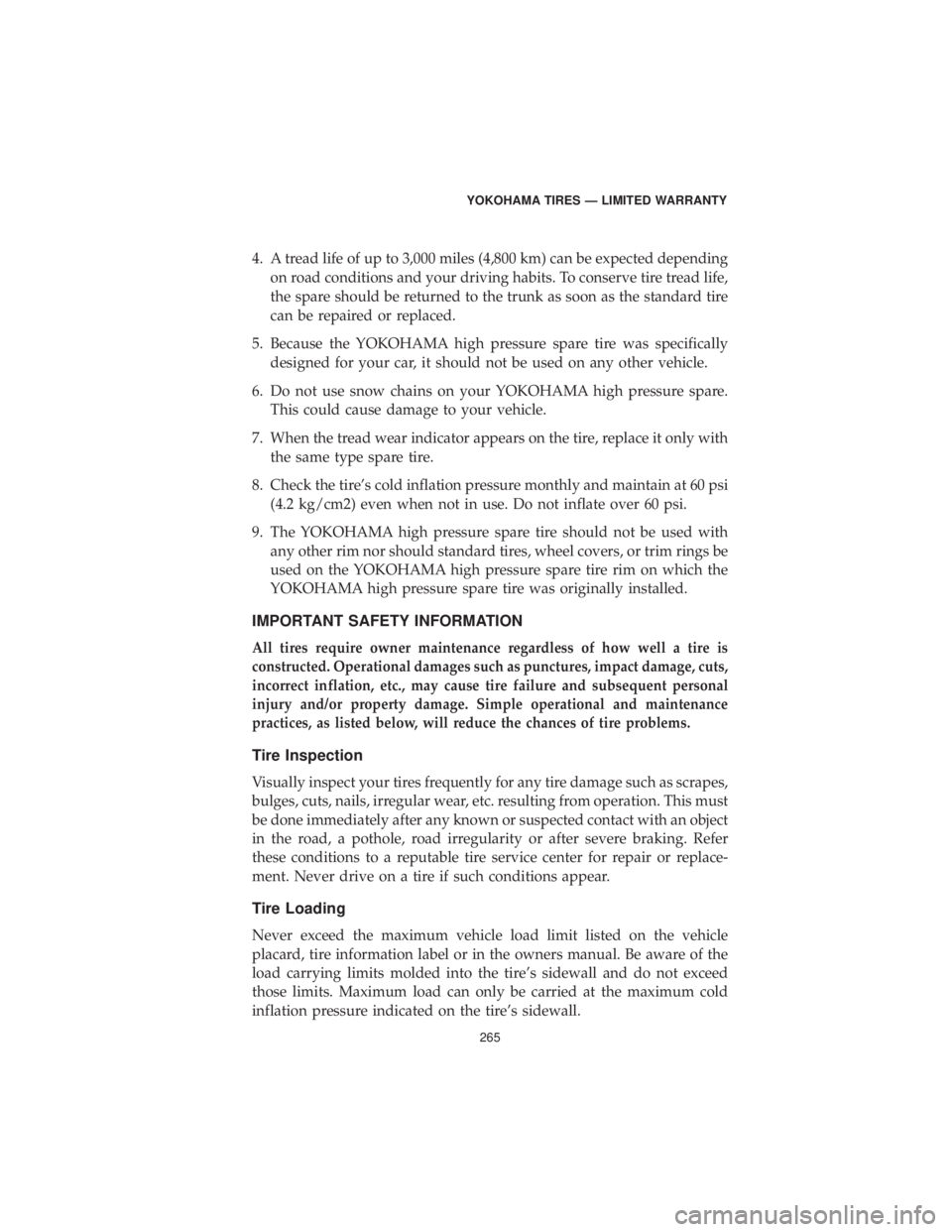
4. A tread life of up to 3,000 miles (4,800 km) can be expected dependingon road conditions and your driving habits. To conserve tire tread life,
the spare should be returned to the trunk as soon as the standard tire
can be repaired or replaced.
5. Because the YOKOHAMA high pressure spare tire was specifically designed for your car, it should not be used on any other vehicle.
6. Do not use snow chains on your YOKOHAMA high pressure spare. This could cause damage to your vehicle.
7. When the tread wear indicator appears on the tire, replace it only with the same type spare tire.
8. Check the tire’s cold inflation pressure monthly and maintain at 60 psi (4.2 kg/cm2) even when not in use. Do not inflate over 60 psi.
9. The YOKOHAMA high pressure spare tire should not be used with any other rim nor should standard tires, wheel covers, or trim rings be
used on the YOKOHAMA high pressure spare tire rim on which the
YOKOHAMA high pressure spare tire was originally installed.
IMPORTANT SAFETY INFORMATION
All tires require owner maintenance regardless of how well a tire is
constructed. Operational damages such as punctures, impact damage, cuts,
incorrect inflation, etc., may cause tire failure and subsequent personal
injury and/or property damage. Simple operational and maintenance
practices, as listed below, will reduce the chances of tire problems.
Tire Inspection
Visually inspect your tires frequently for any tire damage such as scrapes,
bulges, cuts, nails, irregular wear, etc. resulting from operation. This must
be done immediately after any known or suspected contact with an object
in the road, a pothole, road irregularity or after severe braking. Refer
these conditions to a reputable tire service center for repair or replace-
ment. Never drive on a tire if such conditions appear.
Tire Loading
Never exceed the maximum vehicle load limit listed on the vehicle
placard, tire information label or in the owners manual. Be aware of the
load carrying limits molded into the tire’s sidewall and do not exceed
those limits. Maximum load can only be carried at the maximum cold
inflation pressure indicated on the tire’s sidewall.
YOKOHAMA TIRES — LIMITED WARRANTY
265
Page 267 of 270
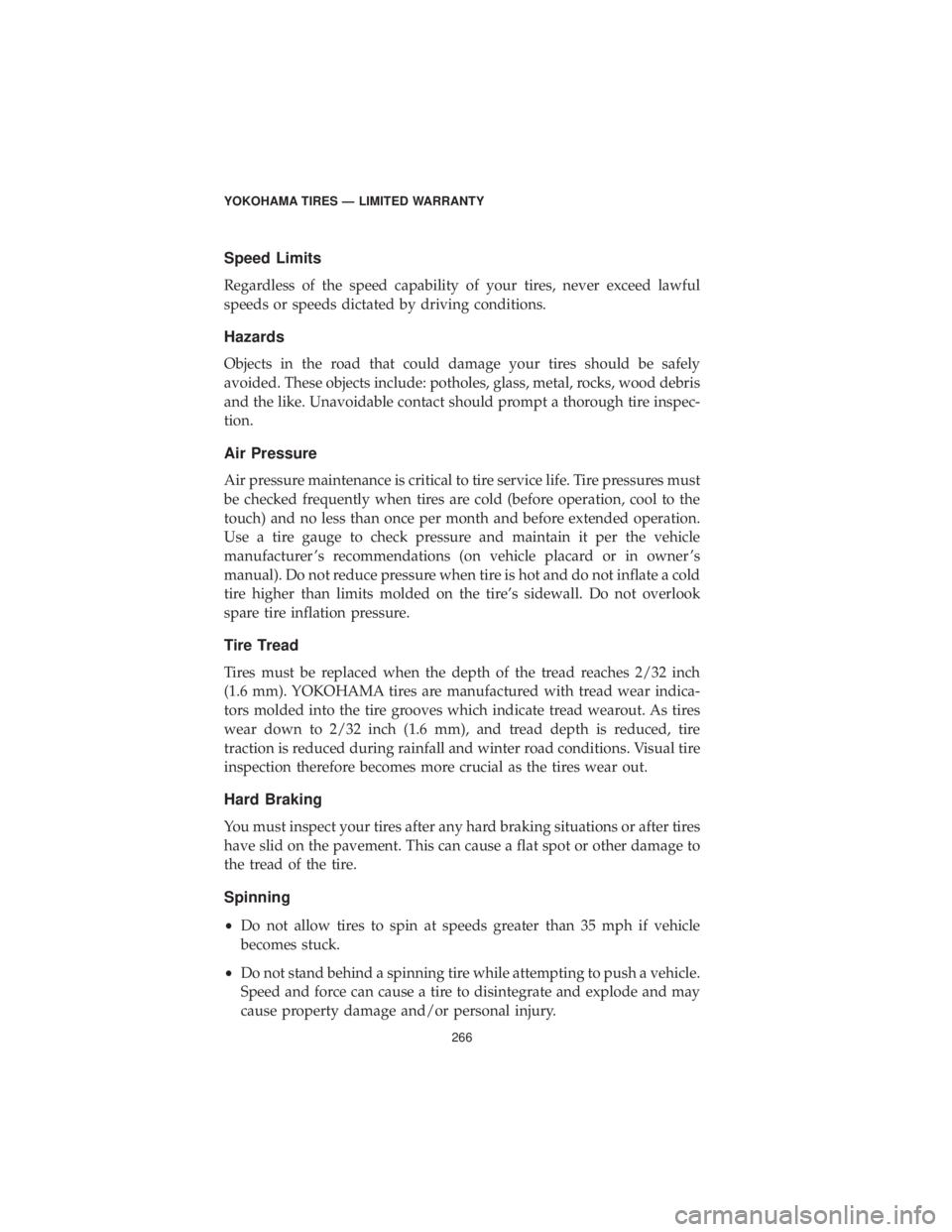
Speed Limits
Regardless of the speed capability of your tires, never exceed lawful
speeds or speeds dictated by driving conditions.
Hazards
Objects in the road that could damage your tires should be safely
avoided. These objects include: potholes, glass, metal, rocks, wood debris
and the like. Unavoidable contact should prompt a thorough tire inspec-
tion.
Air Pressure
Air pressure maintenance is critical to tire service life. Tire pressures must
be checked frequently when tires are cold (before operation, cool to the
touch) and no less than once per month and before extended operation.
Use a tire gauge to check pressure and maintain it per the vehicle
manufacturer ’s recommendations (on vehicle placard or in owner ’s
manual). Do not reduce pressure when tire is hot and do not inflate a cold
tire higher than limits molded on the tire’s sidewall. Do not overlook
spare tire inflation pressure.
Tire Tread
Tires must be replaced when the depth of the tread reaches 2/32 inch
(1.6 mm). YOKOHAMA tires are manufactured with tread wear indica-
tors molded into the tire grooves which indicate tread wearout. As tires
wear down to 2/32 inch (1.6 mm), and tread depth is reduced, tire
traction is reduced during rainfall and winter road conditions. Visual tire
inspection therefore becomes more crucial as the tires wear out.
Hard Braking
You must inspect your tires after any hard braking situations or after tires
have slid on the pavement. This can cause a flat spot or other damage to
the tread of the tire.
Spinning
•Do not allow tires to spin at speeds greater than 35 mph if vehicle
becomes stuck.
• Do not stand behind a spinning tire while attempting to push a vehicle.
Speed and force can cause a tire to disintegrate and explode and may
cause property damage and/or personal injury.
YOKOHAMA TIRES — LIMITED WARRANTY
266